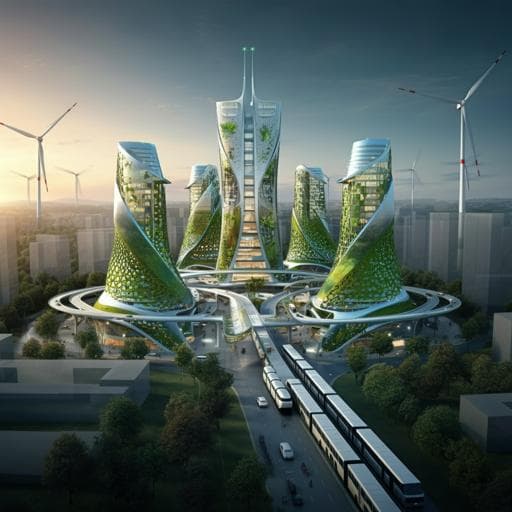
Engineering and Technology
Strategies to save energy in the context of the energy crisis: a review
M. Farghali, A. I. Osman, et al.
Discover urgent energy-saving solutions in the current context of climate change and global crises. This research explores green alternatives to fossil fuels, advancements in energy-efficient technologies, and innovative applications of artificial intelligence, conducted by Mohamed Farghali, Ahmed I. Osman, Israa M. A. Mohamed, Zhonghao Chen, Lin Chen, Ikko Ihara, Pow-Seng Yap, and David W. Rooney.
~3 min • Beginner • English
Introduction
The paper addresses the pressing research question of how societies can rapidly reduce energy demand and emissions amid an ongoing energy crisis aggravated by the Russia–Ukraine war, pandemic recovery, and climate change. It frames energy saving as essential for energy security, affordability, and achieving Paris Agreement targets, noting that fossil fuel dependence drives greenhouse gas emissions and that policy responses risk carbon lock-in. The review focuses on actionable strategies across sectors—heating, buildings, transport, and the power system—and the enabling role of artificial intelligence. It emphasizes the importance of efficiency, conservation, behavioral change, and system-level integration to meet EU and global decarbonization goals while mitigating the social and economic impacts of volatile energy prices.
Literature Review
As a narrative review, the article synthesizes a large body of literature from the IEA and peer-reviewed studies on: (1) the current energy crisis and its macroeconomic and social impacts; (2) decarbonized heating options (biomass boilers, hybrid heat pumps, geothermal, solar thermal/PV-electric boilers, CNG/biomethane); (3) building energy efficiency and passive design, with international case studies (KSA, China, Iran, USA, Singapore, Qatar); (4) transport efficiency, EVs, automation/connectivity; (5) hydrogen’s role across sectors; and (6) AI applications for forecasting, control, and optimization across energy systems. It also reviews systemic transition studies (e.g., Germany’s Energiewende) and energy storage (compressed air energy storage in China), integrating technical, environmental, and economic evidence. Prior research demonstrates substantial potential for energy savings via efficiency, electrification, and AI-driven optimization, while highlighting infrastructure, cost, and policy barriers.
Methodology
This is a comprehensive narrative review and synthesis. The authors: (1) collate sectoral energy statistics (e.g., IEA energy supply and consumption by sector); (2) survey technology-specific studies for residential and commercial heating (biomass, heat pumps, geothermal, solar thermal/PV-electric boilers, CNG/biomethane), extracting quantitative performance, cost, and emissions outcomes; (3) summarize building energy-saving strategies through multi-country case analyses and tabulated evidence; (4) compare vehicle technologies using reported efficiency, energy loss, and cost-per-kilometer reductions; (5) assess hydrogen applications and system-level feasibility studies; (6) compile AI applications and meta-analyses reporting energy savings across buildings, HVAC, lighting, ICT, and grids; (7) present case studies: Germany’s pathway to 100% renewables by 2050 and China’s compressed air energy storage (CAES) development, including technical variants, grid roles, and economic/policy challenges. No new experimental data are produced; the methodology centers on literature aggregation, cross-study comparison, and thematic synthesis of technical and economic insights.
Key Findings
- Energy crisis context: In 2021, the EU imported ~45% of gas and nearly 40% of total gas consumption from Russia; price shocks since mid-2021 caused record fossil prices and high electricity prices. Global energy supply in 2020 was 584,523,552 EJ; consumption 400,819,444 EJ, with 30.01% industry, 26.18% transport, 22.08% residential.
- Heating alternatives: Biomass boilers can cut CO2 by up to 94% and save 39–63% of energy costs over lifecycle; pellet systems achieve high efficiency (up to ~98% peak collection, overall 70–90%) but have higher installation/maintenance costs and potential local air pollutant issues. Hybrid heat pumps and PV-HP systems reduce energy use by ~9–70%, CO2 by ~52%, and costs up to ~56%, but face capacity limits, complexity, and refrigerant needs. Geothermal systems reduce CO2 by ~34–76%, fossil use by ~78%, and can save ~27–60% energy costs, though with high upfront costs; lifetimes up to ~50 years. PV-electric boilers can reduce lifecycle heating costs by up to ~58.9% and CO2 by ~49%, but show low end-use efficiency (~20%) and high operating costs without further efficiency gains. Solar thermal reduces CO2 (e.g., 771–824 kg/year per home), decreases electricity use (~25% in case studies), and can meet substantial thermal demand shares.
- Buildings: Energy saving measures across countries show potential reductions from ~5–40% via passive design (light shelves, green roofs, wind catchers, roof ponds, underground houses), optimized HVAC (multi-chiller optimization 20–40%), retrofits (envelopes, lighting, HVAC), and IoT/controls (up to ~20%). Sector targets require at least 50% direct emission cuts by 2030 for net-zero stock by 2050. Overall, 10–40% of building energy can be reduced by integrating renewables, passive strategies, efficient systems, smart grids, and intelligent monitoring.
- Transport and vehicles: EVs show the highest cost-per-km reduction (~75%) and lowest energy loss (~33%); other technologies have higher losses (diesel 80%, petrol 86%, LPG 84%, NGV 81%, fuel cell 78%, PHEV 55%). Automated and connected driving can save ~5–30% energy (e.g., 3% from grade info, up to 10% with signal data, 20% at reservation-based crossings). Integration of PV/EVs/buildings yields substantial savings (e.g., 66% annual savings in a residential case; lab microgrid savings ~$3.70/day).
- Hydrogen: Valuable as an energy carrier and storage medium; near-term best roles include industrial feedstock and as e-fuel feedstock rather than direct end-use in heating or general transport due to low overall system efficiency and high infrastructure costs. Onboard cold energy utilization in liquid hydrogen heavy-duty trucks can reduce parasitic power up to 15% and achieve 9–15% annual energy savings depending on climate.
- AI for energy: AI/ML enables forecasting, optimal control, and predictive maintenance across energy systems. Reported savings include: building energy cost reductions ~35%; HVAC ~25–60%; lighting up to ~50%; ICT power up to ~70%; renewable integration achieving continuous 30% peak output to microgrids; city-scale smart management ~30% savings. DNN-based building controls achieved ~18.97–42.60% energy reduction. AI can automate generation, transmission, and distribution operations and support real-time grid balancing and trading.
- Case studies: Germany’s 2050 100% renewable transition is technically feasible with deep efficiency, sector coupling, electrification of heat/transport, and limited biomass; hydrogen remains important mainly for fuels/feedstocks. China’s CAES: cycle efficiencies ~50–60% (demo), potential roles in peak shaving, reserves, and renewable integration (wind/solar), including underwater CAES for offshore wind; commercialization constrained by efficiency, storage geology, and market incentives.
- Individual actions: IEA’s 10-point plan suggests behavior changes could immediately save ~0.6 million barrels/day of oil, 17 bcm of gas, and 30 TWh electricity annually in the EU context.
Discussion
The review demonstrates that substantial, near-term energy savings are achievable by combining end-use efficiency, behavioral changes, and system-level integration. Green heating technologies and passive building strategies directly reduce thermal loads and emissions, addressing residential and commercial demand drivers. In transportation, electrification, automation, and integration with building energy systems deliver the largest efficiency gains, while recognizing current battery and infrastructure constraints. AI emerges as a cross-cutting enabler, improving forecasting, control, and asset management to reduce losses and integrate variable renewables at scale. Systemic transition analyses (Germany) underline that achieving deep decarbonization requires coupling sectors, prioritizing efficiency, maximizing renewable electricity, and using hydrogen strategically where electrification is challenging. Energy storage (notably CAES in China) can enhance grid flexibility and renewable utilization but needs technical improvements and market reforms. Together, these findings support the hypothesis that coordinated technology, policy, and behavioral interventions can materially lower energy demand and emissions, strengthening energy security during crises.
Conclusion
- The current energy crisis underscores the urgency of reducing dependence on imported fossil fuels while accelerating efficiency and renewable deployment.
- Household and district heating can be decarbonized via heat pumps (including hybrid and PV-assisted), geothermal, solar thermal, and sustainably sourced biomass; PV-electric boilers can complement when coupled with storage and smart control.
- Buildings can achieve 10–40% energy savings through passive design, envelope and system retrofits, smart controls, and on-site renewables, aligned with net-zero targets.
- Transport decarbonization via EVs offers the highest energy efficiency; connected/automated driving and smart charging strategies further reduce energy use. Hydrogen’s optimal roles are as storage and feedstock/e-fuels for hard-to-electrify sectors.
- AI across the energy value chain provides sizable, scalable savings and improved integration of variable renewables.
- Case studies (Germany’s 2050 pathway; China’s CAES) illustrate both feasibility and practical challenges in achieving high-renewable systems.
Future research should prioritize: improving heat pump refrigerants and seasonal performance; lowering geothermal and retrofit capital costs; advancing cost-effective storage (including CAES) and grid-services markets; addressing EV battery cost/weight, charging, and supply chains; optimizing hydrogen’s system-level roles; and deploying robust, secure AI for energy operations with standardized, interoperable frameworks.
Limitations
- Technology-specific constraints: biomass heating can produce local air pollutants and has higher O&M; hybrid heat pumps face capacity limits, complex integration, and refrigerant concerns; geothermal requires high upfront capital and suitable geology; PV-electric boilers show low end-use efficiency and can have high operating costs without storage/controls.
- Transport barriers: EVs face battery-related issues (range, charging time, cost, weight); hydrogen end-use in heating and general transport is often inefficient and infrastructure-intensive.
- Storage challenges: CAES efficiency remains below ideal; siting depends on suitable geology (salt caverns, mines); artificial storage vessels are costly; limited ancillary markets and incentives hinder commercialization in China.
- Economic and regional variability: Payback periods for building retrofits can be long; performance and feasibility vary by climate, building type, and local policies. Some reviewed frameworks are conceptual or lab-scale, requiring real-world validation.
- Review scope: As a narrative synthesis, results rely on reported studies with varying methodologies and boundary conditions; cross-study comparability and transferability may be limited.
Related Publications
Explore these studies to deepen your understanding of the subject.







